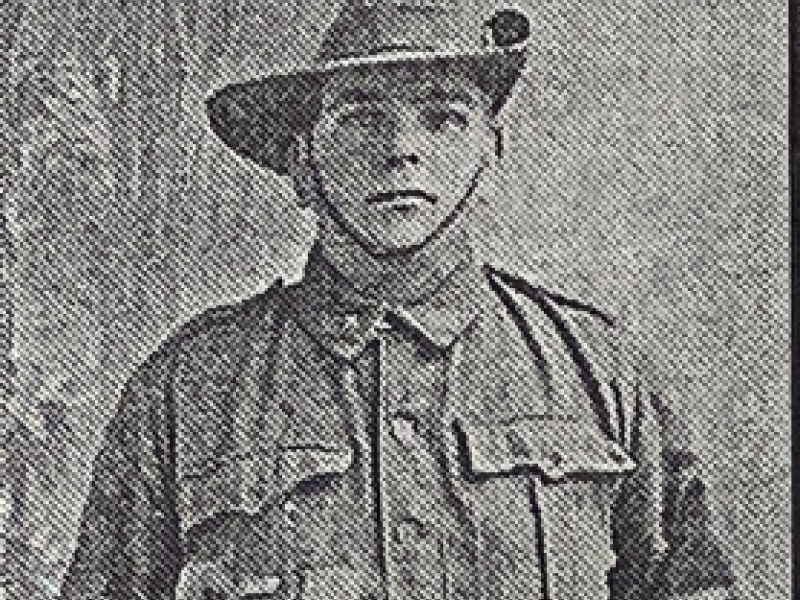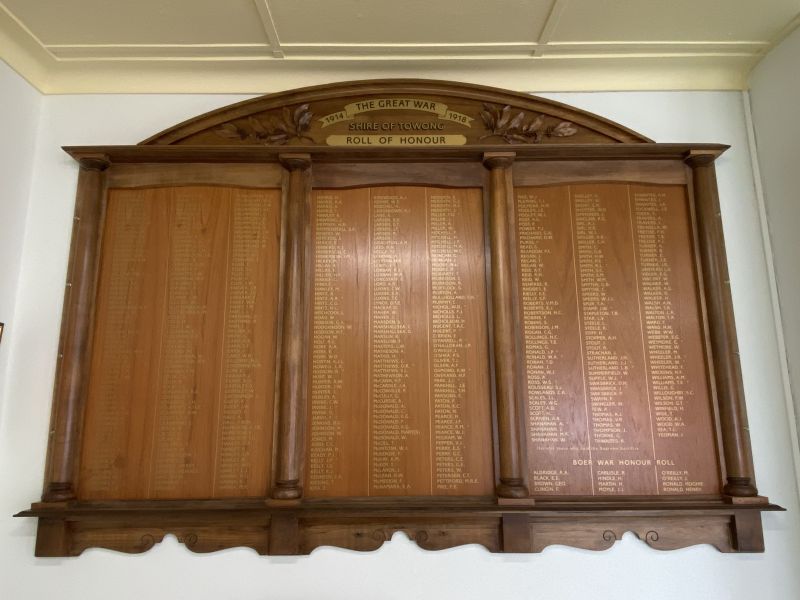John Wesley Stamp
John Wesley Stamp was born at Mitta Mitta, Victoria on the 16th of July 1894. He would be the second eldest of ten children to John and Mary Jane (née Penman), although two of John’s siblings would both die before their first birthday.
John attended the local Mitta Mitta State School in his youth along with helping out on the family farm at Scrubby Creek, where the family milked cows. He was farewelled from the area in July of 1916 at the Mechanics Institute. It was in conjunction with the “Mitta Queen of the Carnival” fund raising social. He was presented with a Swan fountain pen. The 13th of July 1917 edition of the Upper Murray and Mitta Herald stated that there was a strong crowd despite the heavy rains and floods experienced at the time.
John enlisted on the 30th of June 1916. He was allocated the Regimental Number 1936 and placed into the 2nd Reinforcements for the 37th Battalion. On the 16th of August of that year, the 2nd Reinforcements embarked on the RMS Orontes at Melbourne. Around six weeks later they disembarked at Plymouth on the south coast of England.
The next four months would be spent with the 10th Training Battalion at Larkhill in Wiltshire, sharpening up skills that would be needed at the front. On the 4th of February 1917 John proceeded overseas to France aboard the SS Invicta. After a short three day stay at the 3rd Division Base Depot at Etaples, he joined the 37th Battalion in the field at Rue Marle near Armentiéres on the French-Belgium border. John was admitted to the 9th Australian Field Ambulance on the 19th of February suffering from a skin condition that was brought on by lice. This condition had sufficiently healed nine days later for him to rejoin his battalion.
In early June of 1917, the Australian 3rd Division, as part of a three Army Corp allocation (between 200,000 and 300,000 men,) took place in the Battle of Messines. This was the first large scale action involving Australian troops in Belgium and the first for the 3rd Division, of which the 37th Battalion was part of. At 0310 hours on the 7th of June 1917, nineteen powerful mines exploded under the German trenches along the Wytschaete - Messine ridge. It was estimated that these caused 10,000 German casualties. Supported by heavy artillery fire, the Allied troops surged forward. The 3rd Division, including John in the 37th Battalion, made a successful attack alongside the New Zealand Division south of the Messines village.The casualty list for the 37th Battalion from this action included 67 killed, 331 wounded and 4 missing. One of those initially listed as “missing in action” was Private John Wesley Stamp.
To a family, the term “missing in action” does not allow any closure on the death of a loved-one. Some families continued to hope that their son, or daughter, would walk through the front door. The amount of correspondence between the Stamp family and the Base Records Department at Victoria Barracks in Melbourne, indicate that neither John senior or Mary, gave up hope that their son may still be alive.
On March the 6th 1918, John senior wrote the first of many letters to Base Records. He had received conflicting reports about what had happened to his son and was urgently seeking clarification.
“I am enclosing 2 letters which we received from the Red Cross also one from the Chaplain. They being the only ones we have so far received about No. 1936 Pte. J.W. Stamp. I was speaking to No. 579 Pte. J.R. Enever 37th Batt who has returned home lately. He said he saw my son on 6th June 1917. On the 7th June while fighting in the battle of Messines Pte Enever said he was a few lines ahead of my son, so he does not think he could be taken prisoner. When he heard that my son was missing he inquired of his mates to see if he could get any information as to whether he was killed or what had happened to him, but failed to get any. No. 1794 Pte. R. E. Bartel 37th Batt wrote to his sister Sept 11th 1917 and stated that he heard Pte Stamp went through the dressing station. And also that he passed through the Casualty Clearing Station. As I have had no definite news of my son I would be glad if you could find out any further information for me as it is such an anxious time.
Yours sincerely
John Stamp”
Two weeks later, Mary, John’s mother, also wrote to Base Records again asking for more details about how John had died, where was he buried and were they able to receive some of John’s possessions. The letter is fraught with despair about not knowing what had happened to her son.
For the family of a soldier listed as “missing”, hope was something that they clung to. On August the 12th 1922, five years after John had been posted as missing, Mary, wrote to the Manager of Base Records .
“Dear Sir
As I heard that there were some unknown soldiers in France and England, I am writing to ask you if it were possible to have their photographs printed in “the Leader” or “Argus” as my son was reported “missing” during the war I thought there may be the chance of picking him out of a photograph.
Hoping for an early reply
Yours sincerely
Mary, J Stamp”
The reply came two weeks later.
“Dear Madam,
… it is regretted there is no reason to doubt the authenticity of the report that he was killed in action between the 7th and 9th June 1917. … all soldiers who were admitted to hospitals or mental institutions have been satisfactorily accounted for.
The only information available regarding the burial of your son is to the effect that his remains were interred at a site between BETHLEHEM FARM and SEPIEME BARN, approximately 700 yards south east of Messines. As no report has been received that his grave has since been discovered, it would appear that the Graves Service have failed to locate the site. …
Yours faithfully,
Major,
Officer i/c Base Records.”
On Arbour Day in 1920, residents of Mitta planted trees in Magorra Park, along the back of the golf course, to honour those who did not return. John Stamp was one of those who was honoured.
John has no known grave and is listed on the Menin Gate memorial (Commonwealth Memorial to the Missing of the Ypres Salient). He is also remembered on the Australian War Memorial Roll of Honour, the Mitta Mitta State School Honour Roll and the Towong Shire Boer War and WW1 Roll of Honour at Tallangatta, Victoria. For his service, he was awarded the British War Medal and the Victory Medal.

 Stephen Learmonth
Stephen Learmonth